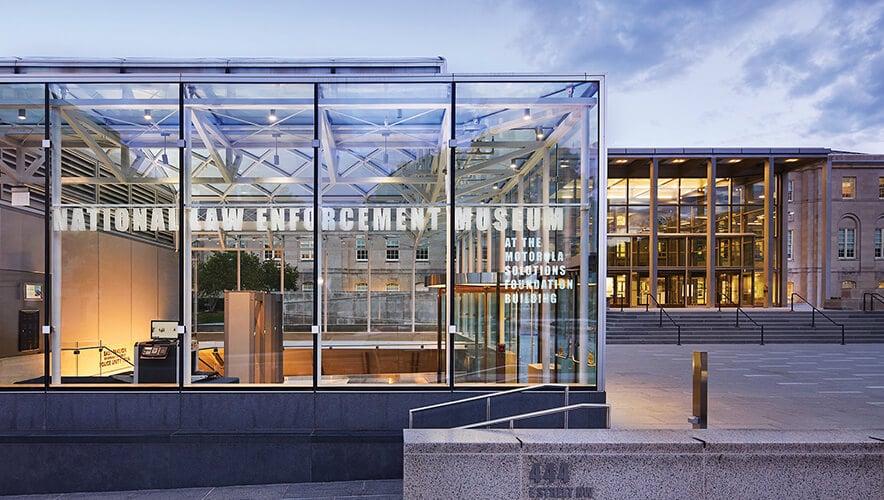Museum Adopts Boon Edam Door Solution
Boston had the Watchmen in 1631. Eighteen years later, New Amsterdam followed suit and formed its own citizen-funded force to help keep the peace in the New World.
Following the American Revolution and massive growth on the East Coast of the United States, city officials knew they needed a more permanent solution to establish law and order. So in 1844, New York City (formerly New Amsterdam) established the nation’s first police department. Officially organized in 1845, it used the London Metropolitan Police as a model to prevent crime and disorder and provide public services.
Since then, other U.S. cities followed suit to create the thousands of police departments across the country that now employ more than 1 million law enforcement officials, according to the Bureau of Justice Statistics.
To document and share the history of American law enforcement, in 2000 the U.S. Congress and then-U.S. President Bill Clinton authorized the establishment of the National Law Enforcement Museum, located just off the National Mall in Washington, D.C., at Judiciary Square.
Davis Buckley Architects (DBA) and Planners—which previously designed the National Law Enforcement Memorial—was selected to design the museum. Clark Construction broke ground on the museum in 2010 in a ceremony attended by law enforcement leaders and activists.
“We recognize that public safety is a partnership between law enforcement and the citizens they serve,” said Craig W. Floyd, National Law Enforcement Officers Memorial Fund chairman and CEO, during the ceremony. “This museum will strengthen that partnership by helping people to better understand and appreciate the value of policing in America.”
Conscious of spatial constraints imposed by the existing buildings and the space allotted to the new museum on Judiciary Square, DBA designed it as an LEED-certified facility mainly below ground.
Visitors enter the museum through one of two visible above-ground glass pavilions before going through a security screening area and onto a mezzanine floor that overlooks 18,000 square feet of exhibit space housing more than 20,000 artifacts. To facilitate access and secure entry, the museum needed two door solutions for the glass pavilions that would fit with the design elements and be energy efficient, says Paul Larson, senior director of operations and security at the National Law Enforcement Museum.
DBA ultimately chose Boon Edam’s BoonAssist TQ manual revolving doors with all-glass door wings. Installed in each pavilion, the doors are made primarily from glass with limited stainless-steel components for structural strength.
“The decision was really made on aesthetics—how well they matched with the two glass pavilions,” Larson says, adding that the revolving door was attractive because it slows people down as they attempt to enter the museum. “That gives security staff time to evaluate if they should enter.”
The doors use a low-energy drive to help users push the door, so it revolves smoothly to allow them to enter the museum. On average, roughly 300 to 500 people visit the museum each day. But during Police Week the museum averaged approximately 3,000 people per day.
“We have a candlelight vigil on one of the nights that is attended by tens of thousands of people on the National Mall, in addition to multiple celebrations during the week,” Larson says. “During this peak time, we typically have 150 visitors enter the museum’s doors every 15 minutes.”
The low-energy drive also helps with speed control and setting the door into a home position when it is not in use. This function maximizes air sealing on the door to prevent unwanted air infiltration—a major concern for the museum, which tries to be as climate controlled as possible to protect exhibits.
“The doors work very well in keeping out extreme weather conditions and keeping interior temperature level at what it’s supposed to be set at,” Larson explains. “In the winter, it’s often 65 inside and 25 outside; the doors work as a buffer to keep us at that comfort level.”
Additionally, the doors are programmable, which means they can be set to open and close at specific times—such as at 6:00 p.m., when the museum closes for the day. The doors also require power only for lighting purposes, so if there is a power outage they will continue to function, and a generator will kick on to provide lighting.
And in an emergency, such as a fire, the doors would unlock to allow visitors and staff to exit the museum quickly. The museum also has a separate handicap and ADA-compliant entrance next to the Boon Edam solution.
Because the museum was only recently completed, the facility is continuing to settle, so some adjustments have been made to ensure the doors continue to seal properly.
“We had one problem where someone pushed the door really hard and popped it off its track, but that was fixed right away,” Larson says, adding that there have been no other issues.
“We just marked our one-year anniversary and reassessed everything,” Larson explains. “Just about everything we’d designed is functioning the way it was intended to.”
For more information, contact Tracie Thomas: [email protected].
Museum 101
The National Law Enforcement Museum at the Motorola Solutions Foundation Building opened in 2018 and is home to more than 20,000 items that show what it’s like to “walk in the shoes” of a law enforcement officer.
The museum features exhibits on the 9/11 terror attacks, forensics and DNA analysis, pop culture portrayal of law enforcement, training simulations, corrections officers, and Special Weapons and Tactics (SWAT) team officers.
Specific artifacts in the museum include the U.S. Park Police helicopter “Eagle One” that responded to the Air Florida Flight 90 crash in 1982, a sheriff’s writ from 1703, a RoboCop movie costume, and handcuffs, nightsticks, and other law enforcement tools.
The museum also acquired the J. Edgar Hoover estate, which includes personal and professional objects that the FBI director obtained during his lifetime.
